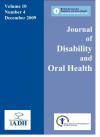Journal of Disability and Oral Health

- Cover Date:
- December 2009
- Print ISSN:
- 1470-8558
- Vol:
- 10
- Issue:
- 4
Frequency and distribution of gingival bleeding in a population of para-athletes competing at the III Para-Pan-American Games in Rio de Janeiro 2007
Aim: Prevalence of gingivitis is high in most populations and physical impairments may jeopardise oral hygiene skills, leading to gingival bleeding. This aimed to evaluate the frequency and distribution of gingival bleeding among para-athletes. Design: A cross-sectional randomised study. Invitations were sent to over 1,300 para-participants of the III Para-Pan-American Games. A modified version of the Eastman Interdental Bleeding Index (EIBI) was adopted to assess gingival inflammation (Modified EIBI). Individuals were separated according to their physical impairments: GI– visually-impaired, with 2 subgroups: GI-a- with late-acquired-visual-impairment and GI-c- with either congenital or early-acquired-visual-impairment; G-II- with impaired upper-limbs; with 1 subgroup: G-II-t- with bilateral impairment or absent limbs; G-III, with lower limbs disabilities. The frequency and distribution of interdental bleeding were calculated and compared between groups. Results: 121 individuals were examined, 95(78.51%) males, with mean age 32.6(sd±9.6). 29 individuals (23.97%) and 66 sites (3.03%) showed interdental bleeding. Frequencies were: G-I (8.12%+2.94); G-I-a (5.56%+2.45); G-I-c (10.7%+3.4); G-II (1.1%+0.4); G-II-t (0%); GIII (1.7%+0.7). Significant differences were found in G-I>G-III (p=0.0002); G-I-c>G-I-a (p=0.042). Males showed higher frequency of bleeding (3.6%±1.7) than females (0.8%+0.5%), p<0.01. Conclusions: Interdental bleeding is a common condition in this population with special needs and is influenced by different physical impairments. The EIBI is a valuable tool for screening large populations and can be easily used for assessing gingival health conditions among athletes with physical disabilities. The modified-EIBI is also a valuable tool for screening large populations at major sports events, and can be easily used to assess gingival health conditions among individuals with special needs.
Key words: Disabilities, gingival bleeding, para-Pan-American games, special needs
- Article Price
- £15.00
- Institution Article Price
- £
- Page Start
- 163
- Page End
- 168
- Authors
- P LS Evans, R A Andrade, F R Guedes, A M Guedes, J A Grangeiro, E MB Tinoco
Articles from this issue
- Title
- Pg. Start
- Pg. End
- An audit of a protocol for the management of patients with hereditary bleeding disorders undergoing dental treatment
- 151
- 155
- Parental perceptions of oral health and access to oral health care services for children with special educational needs in South Bedfordshire
- 156
- 160
- Frequency and distribution of gingival bleeding in a population of para-athletes competing at the III Para-Pan-American Games in Rio de Janeiro 2007
- 163
- 168
- Retrospective audit of the prescribed systemic medication taken by adults using Salaried Primary Care Dental Services in Warwickshire and implications for dental care
- 169
- 174
- The knowledge and attitudes of North Wales healthcare professionals to bisphosphonate associated osteochemonecrosis of the jaws
- 175
- 183
- Strategies for the prevention of dental caries in people with disabilities: a review of risk factors, adapted preventive measures and cognitive support
- 184
- 192
